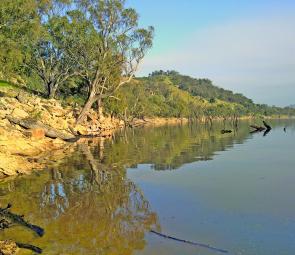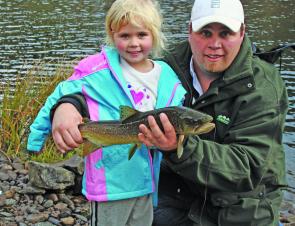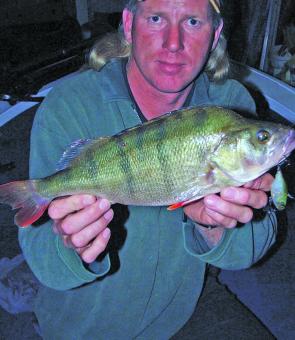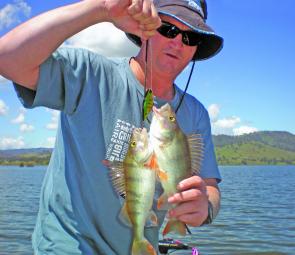Only a three or so hour drive from Melbourne is Lake Hume on the Victorian/ NSW border.
Construction of the dam began in November 1919 and was completed in 1936.
From 1950-1961 the lake was extended requiring the entire township of Tallangatta to be moved to a new site around 8km away.
Surrounded by picturesque flowing hills and valleys, the lake is one of the main attractions along the border. From waterskiing to fishing, Lake Hume is a regular stop for many family holidays.
Whether coming from the north or south, directions to the lake are well signed, but before you go straight to the lake I would recommend you drop into one of the local tackle stores. This is the best place to get up-to-date on where the fish are biting, what methods are being used, what gear is working, and if you don’t already have one most would stock a map of the lake.
One of the tackle store assistants could mark a few areas for you to try, also this is a good time to make sure your Victorian Fishing licence is in date, as the whole lake is governed by Victorian fishing regulations.
The map is also handy for showing you where all the boats ramps are, as sometimes it can be like ‘peak hour’ with a very long wait, so it’s often easier to head to a quieter ramp and save the hassle.
Due to low rainfall in recent years, the lake water level has been quite low, but this year the rain has come back, the lake recently returned to 100% capacity and the fish haven’t gone far. Trout, English perch (redfin), golden perch (yellowbelly), and carp are common in the lake. There’s even the odd Murray cod. With conditions that can sometimes be very testing to the angler, you’ll find that perseverance will pay off.
North of the Bethanga Bridge is classified as NSW waters but south of that is covered by Victorian boating regulations, so people in any craft under 4.6m are required by law to wear and keep their life jackets on at all times south of the line, although it is probably best t keep them on all the time anyway.
Once on the water and using the knowledge you gained from the locals, it’s time to work out what species of fish you want to target. We’ll start with targeting redfin from a boat.
If you have a fish-finder, start looking for the baitfish around the lake edges and tree lines. They should look like a ball of mass on your screen.
If the trees are under water, but you can see the fish marks, drop anchor and allow the boat to drift directly over the target area, sometimes as little as 1.5m can be the difference between a bag full and no fish at all.
If you don’t have a fish-finder, look for birds that are either sitting in a bunch or hanging around an area then drive the boat around that area stopping at the trees and drop a line.
Before I had my fish-finder, I always put the 5-minute rule into effect. When doing this, if I haven’t had a touch in 5-minutes I’ll move to the next tree, and continue doing this until I found a school of redfin.
This also a good way to get onto some of the bigger golden perch as the schools of small redfin can sometime attract the larger predators.
Although sometimes it’s hard to find the schools, the warmer months are the best time to try for redfin and this also goes for golden perch. I have found that once I find a few redfin and get hook-ups, I’ll stick to the area until it goes quiet.
If possible, bring a big bucket or keeper net to use as a live well if you don’t have one already fitted in your boat. Even if you don’t plan on keeping them, I have found that the other fish spook fairly easily if you throw your catch back before you’re done in that area, so try keeping them alive and release them as you move on.
Using this method I have caught redfin, yellow belly, cod, and an awful lot of carp.
Trolling for redfin will be dependent on lure selection, you could pick up any one of the fish that the lake holds. More on lure selection and tactics later.
The bag limit for redfin is 30 fish.
The yellow belly in the lake are some of the largest caught in the country, and are in fairly good numbers. From late October to late March they can be caught as the water temperature is generally high, sometimes well over 20C.
Targeting them is very much the same as the redfin, dropping bait, soft plastics, vibes, jiggers, casting, and just about everything a tackle store can offer. Generally upgrading line size from 1-2kg line used on the redfin, to 4-6kg line is required. This helps the unwary angler at least have a fighting chance against a 5-7kg fish.
Over the years the trout in the lake have been very hot and cold, last winter and into this one some cracking browns have been pulled out but the numbers are getting lower, as not many fish go back in after being caught regardless of the species.
Good old dirty filthy stinking carp, the vermin that is slowly destroying the lake.
Like many other waterways the carp population would be well into the millions. Despised by many, the carp still puts up a decent fight on light gear, and fly. The main thing with carp, is they are great for the kids and families to target as the kids can learn how to fight a large fish. The carp also make awesome crayfish bait.
As I mostly cast with lures and plastics for fish, I have found dropping soft plastics like Berkley T Tails, and MF-40s to be killers on redfin and golden perch. I will rig the T Tails up either on a jig head or running sinker arrangement and bounce them off the bottom or drift within the tree line.
Another new favourite of mine is a small metal vibe around 1/4oz weight dropped down ledges, and slowly worked through the column of fish on the sounder.
Brands like Atomic, Ecogear, and TT lures are the better ones out there and work like a charm.
Using worms the same way is just as productive, but a new worm every 30 seconds takes the fun out of it very quickly. Yabbies are very good if you’re after bigger fish like goldens or even a Murray cod. And my favourite way is casting the banks, drop-offs, and ledges with an array of lures from SX40’s to large 90mm Oar-gees or spinner baits.
Trolling along with bait fishing is one of the most used methods at Hume by at least 80% of the anglers I talk to.
It’s also a good way to find schools of fish that may be hanging around in a certain area. White, pink, red/black, and perch pattern coloured lures are very commonly used, but the odd random pattern or colour still get fish, I think it’s just a matter of finding the fish in the first place.
The McGrath minnows work well when trolled at the right speed (around 2-3.2kmh) and Lofty’s Cobra type lures in a vast array of colours trolled at 2-4kmh all catch fish on their day.
In all, a visit or a stay can be very rewarding to an angler when fishing Lake Hume, but if the bite is tough sticking it out usually brings results.
With this summer shaping up to be one of the best years on the lake in quite a while, I think you need to come relax and enjoy this fantastic waterway and all it has to offer.
Facts
Bluey’s Hunting and Fishing
Unit 3/65 Thomas Mitchell Drive Wodonga 3690
PH: (02) 60 561259
Capper’s Pro Tackle
Unit 1/62 Thomas Mitchell Drive Wodonga 3690
PH: (02) 60 244029
Mason’s Compleat Angler
343 Wagga Road Lavington 2641
PH: (02) 60 251346
Elk’s Hunting & Fishing
582 David Street Albury 2640
PH: (02) 60 218494
If you’re with the family you can stock up on supplies, do some shopping and check out what Albury-Wodonga has to offer.
Lake Hume Resort, Lake Hume Tourist Park, and Boathaven Holiday Park are three family parks on the lake that have good facilities and affordable prices. Situated on the main body of the lake they are a haven for holiday goers.

Golden Perch can reach a huge size in Hume – some of the biggest around are caught here every season.

Casting to the shore-based structure is a popular method on Hume, which would account for all the busy boat ramps.

Trout shouldn’t be ignored either, as the author and his daughter show here.

Big trout are a feature of the cooler months, as Andy McCarthy shows here.

A good selection of lures for Hume that will snare all the species you are after.

Big redfin are to be expected.

The reddies can go pretty hard at times too!

Berkley T Tails rigged on a smallish jig head is a popular presentation.

If your sounder shows this, then you have found the fish.

Not only is it a productive waterway, it is also very scenic.




